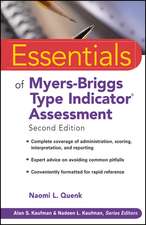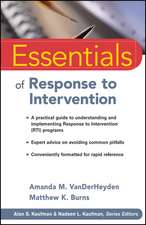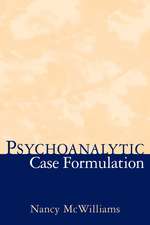MATLAB for Psychologists
Autor Mauro Borgo, Alessandro Soranzo, Massimo Grassien Limba Engleză Paperback – 16 apr 2014
MATLAB for Psychologists expertly guides readers through the component steps, skills, and operations of the software, with plentiful graphics and examples to match the reader’s comfort level. Using an extended illustration, this concise volume explains the program’s usefulness at any point in an experiment, without the limits imposed by other types of software. And the authors demonstrate the responsiveness of MATLAB to the individual’s research needs, whether the task is programming experiments, creating sensory stimuli, running simulations, or calculating statistics for data analysis.
Key features of the coverage:
- Thinking in a matrix way.
- Handling and plotting data. Guidelines for improvedprogramming, sound, and imaging.
- Statistical analysis and signal detection theory indexes.
- The Graphical User Interface.
- The Psychophysics Toolbox.
| Toate formatele și edițiile | Preț | Express |
|---|---|---|
| Paperback (1) | 454.74 lei 6-8 săpt. | |
| Springer – 16 apr 2014 | 454.74 lei 6-8 săpt. | |
| Hardback (1) | 533.85 lei 6-8 săpt. | |
| Springer – 24 mar 2012 | 533.85 lei 6-8 săpt. |
Preț: 454.74 lei
Nou
Puncte Express: 682
Preț estimativ în valută:
87.03€ • 89.90$ • 72.43£
87.03€ • 89.90$ • 72.43£
Carte tipărită la comandă
Livrare economică 25 martie-08 aprilie
Preluare comenzi: 021 569.72.76
Specificații
ISBN-13: 9781489986993
ISBN-10: 1489986995
Pagini: 300
Ilustrații: XVI, 284 p.
Dimensiuni: 155 x 235 x 16 mm
Greutate: 0.42 kg
Ediția:2012
Editura: Springer
Colecția Springer
Locul publicării:New York, NY, United States
ISBN-10: 1489986995
Pagini: 300
Ilustrații: XVI, 284 p.
Dimensiuni: 155 x 235 x 16 mm
Greutate: 0.42 kg
Ediția:2012
Editura: Springer
Colecția Springer
Locul publicării:New York, NY, United States
Public țintă
GraduateCuprins
Chapter 1. Basic operations.- Chapter 2. Data Handling.- Chapter 3. Plotting Data.- Chapter 4. Start Programming.- Chapter 5. A Better Sound.- Chapter 6. Create and Process Images.- Chapter 7. Data Analysis.- Chapter 8. The Charm of Graphical User Interface.- Chapter 9. The PsychToolbox: Video.- Chapter 10. PsychToolBox: Sound, Keyboards and Mouse.
Recenzii
From the book reviews:
“The reviewed book is written to help newcomers in using MATLAB for research in experimental psychology, including others. … Different experiment scripts are presented in the book to enhance readers’ ability to write MATLAB scripts of their own. Each chapter lists explanation tables, functions declaration, and aspects of different declaration values.” (Adriana Horníková, Technometrics, Vol. 55 (2), May, 2013)
“The authors have produced a tutorial-like handbook that might be suitable for lab use in courses where students may have no previous programming experience. It is organized into ten easy-to-read chapters. … The book is clearly written … . This book includes some interesting examples from psychology research, which might also be useful in courses for nonpsychologists. … In summary, this book is a pragmatic hands-on tutorial on MATLAB that might be useful to scientists … including most psychologists and social scientists.” (Fernando Berzal, ACM Computing Reviews, December, 2012)
“The reviewed book is written to help newcomers in using MATLAB for research in experimental psychology, including others. … Different experiment scripts are presented in the book to enhance readers’ ability to write MATLAB scripts of their own. Each chapter lists explanation tables, functions declaration, and aspects of different declaration values.” (Adriana Horníková, Technometrics, Vol. 55 (2), May, 2013)
“The authors have produced a tutorial-like handbook that might be suitable for lab use in courses where students may have no previous programming experience. It is organized into ten easy-to-read chapters. … The book is clearly written … . This book includes some interesting examples from psychology research, which might also be useful in courses for nonpsychologists. … In summary, this book is a pragmatic hands-on tutorial on MATLAB that might be useful to scientists … including most psychologists and social scientists.” (Fernando Berzal, ACM Computing Reviews, December, 2012)
Notă biografică
Mauro Borgo received his B.A. and his Ph.D. in Electronic and Telecommunication Engineer in 1999 and in 2003 respectively, both from the University of Padova, Italy. His interests are in signal and data processing for wireless communication. He adapted his competences of signal processing to the multi-sensor/actuators cells systems. He has an international patent on “Multi site- Single CellElectroporation”. He was a lecturer in “Electrical communication” and in “Matlab” at the University of Padova(Italy).
Alessandro Soranzo received his B.A. in Experimental Psychology in 1999 and his Ph.D. in Experimental Psychology in 2004, both from the University of Trieste, Italy. He also did a Post-doc in Vision Sciences at Glasgow Caledonian University (Glasgow, UK). He is senior lecturer in Cognitive Psychology at Teesside University in Middlesbrough (UK). His research interests are in colour perception and psychophysical methods.
Massimo Grassi received his B.A. in Experimental Psychology in 1997 and his Ph.D. in Experimental Psychology in 2003, both from the University of Padova (Italy). He has also been a Visiting Scientist at University of Sussex (UK). He is lecturer in Sensation and Perception at University of Padova (Italy). His research interests are in sound perception, crossmodal perception, and psychophysical methods.
Alessandro Soranzo received his B.A. in Experimental Psychology in 1999 and his Ph.D. in Experimental Psychology in 2004, both from the University of Trieste, Italy. He also did a Post-doc in Vision Sciences at Glasgow Caledonian University (Glasgow, UK). He is senior lecturer in Cognitive Psychology at Teesside University in Middlesbrough (UK). His research interests are in colour perception and psychophysical methods.
Massimo Grassi received his B.A. in Experimental Psychology in 1997 and his Ph.D. in Experimental Psychology in 2003, both from the University of Padova (Italy). He has also been a Visiting Scientist at University of Sussex (UK). He is lecturer in Sensation and Perception at University of Padova (Italy). His research interests are in sound perception, crossmodal perception, and psychophysical methods.
Textul de pe ultima copertă
The matrix laboratory interactive computing environment—MATLAB—has brought creativity to research in diverse disciplines, particularly in designing and programming experiments. More commonly used in mathematics and the sciences, it also lends itself to a variety of applications across the field of psychology. For the novice looking to use it in experimental psychology research, though, becoming familiar with MATLAB can be a daunting task.
MATLAB for Psychologists expertly guides readers through the component steps, skills, and operations of the software, with plentiful graphics and examples to match the reader’s comfort level. Using an extended illustration, this concise volume explains the program’s usefulness at any point in an experiment, without the limits imposed by other types of software. And the authors demonstrate the responsiveness of MATLAB to the individual’s research needs, whether the task is programming experiments, creating sensory stimuli, running simulations, or calculating statistics for data analysis.
Key features of the coverage:
MATLAB for Psychologists expertly guides readers through the component steps, skills, and operations of the software, with plentiful graphics and examples to match the reader’s comfort level. Using an extended illustration, this concise volume explains the program’s usefulness at any point in an experiment, without the limits imposed by other types of software. And the authors demonstrate the responsiveness of MATLAB to the individual’s research needs, whether the task is programming experiments, creating sensory stimuli, running simulations, or calculating statistics for data analysis.
Key features of the coverage:
- Thinking in a matrix way.
- Handling and plotting data.
- Guidelines for improved programming, sound, and imaging.
- Statistical analysis and signal detection theory indexes.
- The Graphical User Interface.
- The Psychophysics Toolbox.
Caracteristici
Presents examples and terminology that address the specific information needs of psychologists Not only supplies MATLAB routines that can be used in psychology, it also provides a conceptual frame of reference for readers to design their own experiments in psychology Explores connections to such external programs as Excel Is useful for both expert and less-experienced computer programmers Examines the use of specific toolboxes dedicated to psychologists Uses psychological vocabulary combined with real-case examples Includes supplementary material: sn.pub/extras










